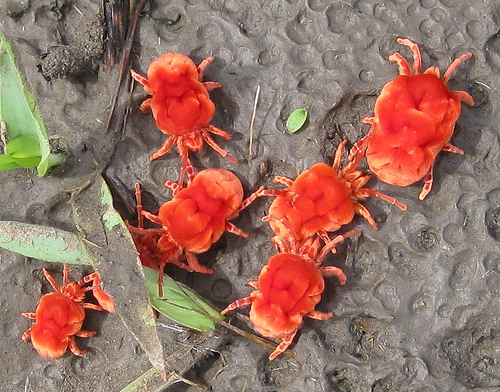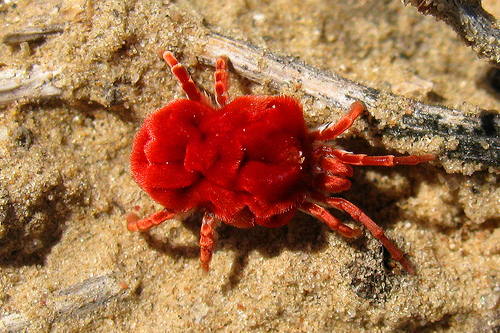Trombidium grandissimum "Giant Red Velvet Mite"
Reproduction
The life cycle of the red velvet mite is very complex and the
rituals leading to fertilization are also uniqu e. The adult male and female mite first perform an encircling dance, tapping their front legs together, and then
signaling threads are deposited to lead the female to the
males' spermatophores. Males then drop their spermatophores on the ground, and the female picks them up,
leading to indirect sperm transfer. If another male comes
along the spermatophores before a female, he will destroy the
spermatophores and lay his own. After fertilization
occurs and the eggs have developed, they are laid in masses in
relatively moist soil and hatch one to two months later. This
is usually synchronized with their hosts life-cycle as well, and
the Giant Red Velvet Mite will spend one to two weeks attached
to its host and then detach and continue its life cycle in soil.
e. The adult male and female mite first perform an encircling dance, tapping their front legs together, and then
signaling threads are deposited to lead the female to the
males' spermatophores. Males then drop their spermatophores on the ground, and the female picks them up,
leading to indirect sperm transfer. If another male comes
along the spermatophores before a female, he will destroy the
spermatophores and lay his own. After fertilization
occurs and the eggs have developed, they are laid in masses in
relatively moist soil and hatch one to two months later. This
is usually synchronized with their hosts life-cycle as well, and
the Giant Red Velvet Mite will spend one to two weeks attached
to its host and then detach and continue its life cycle in soil.
Trombidium grandissimum shares a very
complex lifecycle, but in general a mite's life cycle has four stages: egg, larvae, nymph and adult. A mite's
morphology during the nymph stage is completely different from the adult
stage. For example, nymphs only have six legs instead of the
normal eight. They also cannot reproduce during the nymph stage.
Visit http://www.acari.be/uk/about_a.php to learn more about other cool mites
and about mites in
general.
mite's life cycle has four stages: egg, larvae, nymph and adult. A mite's
morphology during the nymph stage is completely different from the adult
stage. For example, nymphs only have six legs instead of the
normal eight. They also cannot reproduce during the nymph stage.
Visit http://www.acari.be/uk/about_a.php to learn more about other cool mites
and about mites in
general.
Calyptostatic protonymphs develop within the cuticle of the larvae and arises as deutonymphs in late summer. The next step is the development of calyptostatic tritonymphs within the deutonymphs' cuticles. Adults emerge in autumn and will then hibernate in the soil during the winter. The length of this cycle strongly depends on temperature. (Taken from Zhang, Z.-Q. 1998. Biology and ecology of Trombidiid mites (Acari: Trombidioidea).
Continue on to learn more about the Giant Red Velvet Mite's habitat.
Back to main page.